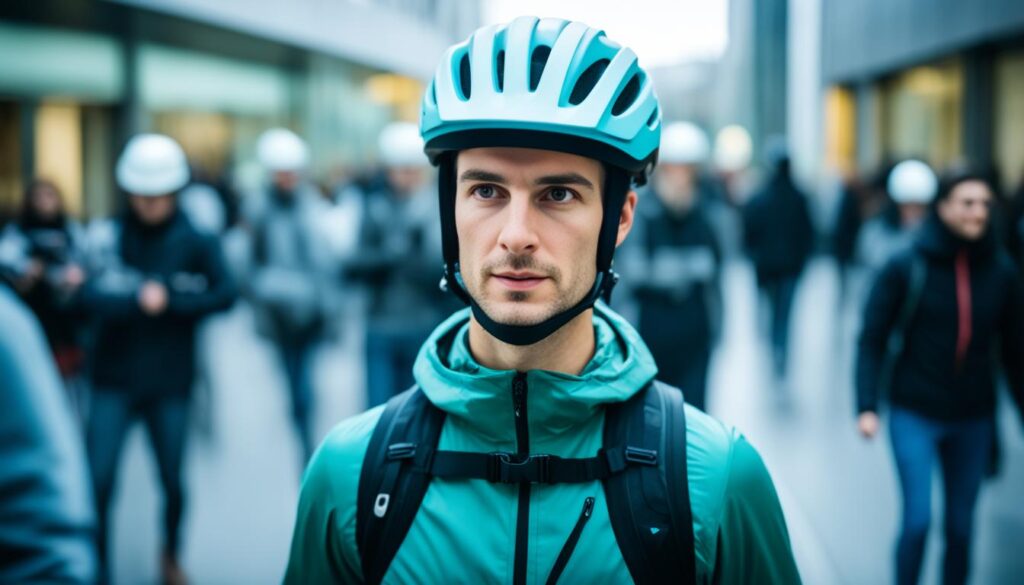
Are helmet cameras invading our privacy in public spaces or providing valuable evidence in accidents? As motorcyclists increasingly turn to wearable cameras to capture their rides, the impact on privacy rights and surveillance technology is raising concerns. Are these cameras a breach of privacy or a necessary tool for personal safety?
Helmet cameras have revolutionized the way motorcyclists document their journeys and protect themselves in the event of an accident. These compact devices can provide crucial evidence, capturing video footage that can refute false claims, demonstrate fault, and enhance accident claims. However, with the rise of wearable camera technology, the question of privacy in public spaces has become more complex.
Join us as we dive into the legal considerations, privacy rights, and the impact of helmet cameras on the broader surveillance landscape. We’ll explore the regulations surrounding wearable camera use, the challenges posed by facial recognition technology, and the importance of complying with privacy laws while using these devices.
Discover how motorcyclists can navigate the fine line between personal safety and privacy concerns when using helmet cameras in public spaces. Are we sacrificing privacy for the greater good, or can we strike a balance to protect both our personal safety and privacy rights?
Key Takeaways:
- Helmet cameras can provide crucial evidence and enhance accident claims for motorcyclists.
- Laws regarding filming in public spaces vary by jurisdiction, and users should be aware of their rights and responsibilities.
- Considerations of privacy, personal data protection, and facial recognition technology are essential when using helmet cameras.
- Striking a balance between safety and privacy is crucial to ensure compliance with applicable laws and regulations.
- Sharing helmet camera footage raises additional legal considerations, such as consent and the public interest.
Benefits of Helmet Cameras for Accident Claims
Helmet cameras are a valuable asset for motorcyclists involved in accidents, providing crucial video evidence that can greatly benefit accident claims. With the ability to capture real-time footage from the rider’s perspective, these cameras are instrumental in refuting false witness statements and police reports that may wrongly assign blame to the motorcyclist.
The footage obtained from helmet cameras can clearly depict the sequence of events leading up to the accident, helping to prove the negligence or recklessness of other drivers involved. This video evidence is especially useful when witness statements conflict or when there are no witnesses at all. It can effectively counter opposing claims, ensuring that fault is accurately determined and the responsible party is held accountable.
Moreover, the camera footage can also showcase the extent of the crash, providing a visual context for the severity of the impact and the resulting injuries. This is particularly beneficial when pursuing compensation for damages and medical expenses, as it helps to establish the magnitude of the accident and the corresponding impact on the motorcyclist’s well-being.
Additionally, the availability of video evidence from helmet cameras can lead to insurance discounts for riders. Many insurance companies recognize the proactive measure that helmet camera usage represents and offer lower rates for riders who can provide such comprehensive evidence in the event of an accident. By capturing critical moments and proving fault, helmet cameras can potentially save motorcyclists both in terms of insurance premiums and overall financial burden.
Insurance Discounts Offered for Helmet Camera Usage
| Insurance Company | Discount Percentage |
|---|---|
| ABC Insurance | 10% |
| XYZ Insurance | 15% |
| DEF Insurance | 20% |
By utilizing helmet cameras and providing video evidence to support accident claims, motorcyclists can not only strengthen their case but also potentially secure insurance discounts from reputable insurance providers.
Privacy Considerations When Using Helmet Cameras
While helmet cameras can provide valuable evidence in accident claims, it is crucial to navigate privacy concerns when using these devices in public spaces. Filming in public is generally allowed as long as there is no reasonable expectation of privacy. However, it is important to be aware of any specific laws and regulations in your jurisdiction regarding public surveillance and data protection.
One important consideration is the use of facial recognition technology, which may capture sensitive information without individuals’ consent. To ensure compliance with privacy rights and data protection laws, it is recommended to be transparent about the use of helmet cameras and inform those around you if you are recording, especially in situations where individuals may have a reasonable expectation of privacy.
It is essential to respect privacy rights and balance the benefits of helmet cameras with the ethical concerns surrounding public surveillance. By understanding the legal framework and being mindful of the potential impact on privacy, helmet camera users can protect both their personal safety and the privacy rights of others.

The Reasonable Expectation of Privacy
When using helmet cameras in public spaces, it is important to understand the concept of a reasonable expectation of privacy. Individuals generally have a lower expectation of privacy in public areas compared to private spaces. Therefore, filming in public is considered acceptable in most cases.
However, it is crucial to respect the privacy rights of others, especially in certain situations where individuals may have a reasonable expectation of privacy. For example, if you are in a public restroom or recording conversations without consent, you may be infringing on privacy rights.
Navigating Facial Recognition Technology
The use of facial recognition technology raises additional privacy concerns. This technology can capture and process individuals’ facial features without their knowledge or consent, potentially leading to the collection of sensitive personal information.
While wearing a helmet camera, it is important to consider the implications of capturing and storing facial recognition data. Ensure that you comply with applicable laws and regulations, and consider whether the benefits of using facial recognition technology outweigh the potential privacy risks.
Transparency and Consent
Transparency and obtaining consent are essential when using helmet cameras in public spaces. It is recommended to inform those around you that you are recording, especially in situations where individuals may have a reasonable expectation of privacy.
By being transparent about your use of a helmet camera, you respect the privacy rights of others and minimize any potential privacy concerns. Additionally, obtaining consent from individuals who may be captured in your footage can help build trust and prevent any misunderstandings.
Balancing Privacy and Safety with Helmet Cameras
The use of helmet cameras raises important questions about the delicate balance between privacy rights and safety concerns. While helmet cameras can undoubtedly enhance the safety of motorcyclists and provide invaluable evidence, it is crucial to navigate the legal framework surrounding their use and ensure the protection of personal data. Moreover, obtaining consent when necessary plays a pivotal role in preserving privacy and complying with applicable regulations.
When using helmet cameras in public spaces, it is imperative to consider the potential intrusion and impact on privacy. Striking a balance between safety and privacy is essential to avoid any unintended violations of individual rights and to maintain compliance with the law.
One key aspect to consider is the legal framework governing wearable camera usage. Different jurisdictions may have specific regulations or guidelines in place to ensure the responsible use of such devices. Familiarizing yourself with these regulations is crucial to use helmet cameras in a manner that respects privacy rights and avoids legal pitfalls.
Moreover, protecting personal data captured by helmet cameras should be a top priority. As motorcyclists record their journeys and encounters, it is vital to handle the resulting footage responsibly and securely. This includes implementing appropriate data protection measures, such as encryption and strict access control, to safeguard sensitive information from unauthorized access.
Obtaining consent is an essential step in respecting privacy rights when using helmet cameras. While filming in public spaces is generally permissible, it may still be necessary to obtain explicit consent from individuals who might have a reasonable expectation of privacy. By ensuring that everyone in the vicinity is aware of the camera’s presence and its recording function, motorcyclists can mitigate potential privacy concerns and foster a culture of transparency.
Overall, successfully balancing privacy and safety when utilizing helmet cameras requires a thorough understanding of wearable camera regulations, a commitment to protecting personal data, and obtaining consent when necessary. By adhering to a proper legal framework and respecting privacy rights, motorcyclists can harness the benefits of these devices while maintaining the privacy and security of all involved.
Legal Considerations for Sharing Helmet Camera Footage
When it comes to sharing helmet camera footage, there are important legal factors to consider. While capturing footage for personal use is generally allowed, sharing that footage with others can potentially raise privacy rights and data protection concerns.
One crucial aspect to keep in mind is obtaining consent from the individuals captured in the footage. It is essential to respect their privacy rights and ensure that they are aware and agree to the sharing of the footage. Additionally, considering the sensitive nature of the information being shared, extra caution must be exercised.
The concept of public interest and freedom of expression may also come into play when deciding whether or not to share helmet camera footage with others. The right to freedom of expression should be balanced against the potential impact on privacy and the legal implications that may arise.
Ultimately, exercise judgment and carefully consider the potential consequences before sharing helmet camera footage. While it can be tempting to share captivating or informative content, it is essential to prioritize privacy rights and ensure compliance with data protection laws. By doing so, you can confidently navigate the legal landscape surrounding the sharing of helmet camera footage.

Conclusion
Helmet cameras serve as a valuable tool for motorcyclists, providing personal safety benefits and potential evidence in accidents. However, it is crucial to navigate privacy considerations and understand the legal framework surrounding their use. Balancing privacy rights and safety concerns is essential to ensure compliance with relevant laws and regulations.
To ensure the ethical and responsible use of helmet cameras, it is important for motorcyclists to be aware of jurisdiction-specific regulations. This includes understanding when consent is required, being transparent about recording in situations where individuals may have a reasonable expectation of privacy, and respecting data protection laws.
By providing motorcyclists with the ability to capture valuable footage, helmet cameras can enhance personal safety and provide critical evidence in the event of an accident. However, it is vital to exercise caution and thoughtfulness when using and sharing this footage to respect the privacy rights of others. Ultimately, by navigating helmet cameras and privacy with care, motorcyclists can protect their safety and privacy rights while enjoying the benefits these devices offer.
Source Links
- https://reolink.com/blog/pros-cons-of-surveillance-cameras-in-public-places/
- https://billallenlaw.com/why-all-motorcycle-riders-should-wear-a-helmet-camera/
- https://cyclingindustry.news/comment-helmet-cameras-and-the-law-where-do-cyclists-stand/
Recommended

Meet James Smith, affectionately known by friends as ‘Biker Smith’, your go-to expert at ‘Best HD Helmet Camera’. At 35, living in the USA, James embodies the spirit of adventure. His life is a thrilling ride, powered by his Harley Davidson Softail and BMW S 1000 RR, with his girlfriend as his favorite travel companion. A software developer by profession, James’s heart beats for the open road, making him a full-time traveler at heart. His passion for biking and technology merges seamlessly on this platform. Recognizing a gap in discussions around helmet cameras, he founded this blog to educate and inspire fellow enthusiasts. His mission? To elevate your riding experience with the best HD helmet camera insights, backed by firsthand experiences, rigorous testing, and a genuine love for the ride. Trust James to guide you through the world of helmet cameras, where quality, innovation, and safety ride together.